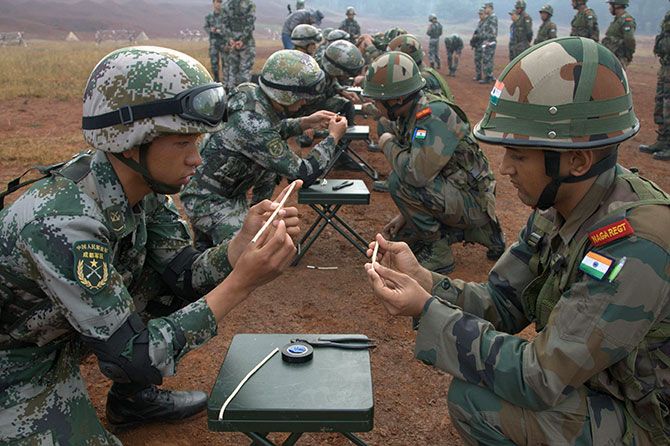'When war is thrust on you as in 1962 and 1965 or is tempting as in 1971, ensure that all other fronts are kept quiet, leaving your army free to deal with one,' says Shekhar Gupta.

General Bipin Rawat's statement that his army is prepared for a two-and-a-half front war has drawn a fair bit of comment.
The fact is, India has faced multiple and multi-layered threats since 1959 and its army has been the political leadership's go-to option.
With one exception, 1962, it has delivered each time.
Many questions, however, arise from this, particularly now when the second front, China, has sprung to life after decades and the language coming out of Chinese official media will embarrass panellists on our commando-comic TV channels.
The first question is, almost 60 years after the two-and-a-half-front challenge first developed, how come it hasn't altered, after three full wars, break-up of Pakistan, many peace accords in the north east, end of the Cold War, and nuclear weaponisation?
No other major nation has continued to have the same combination of threats for six decades.
The second, is this remarkable continuity in existential military threat a result of India's diplomacy and strategic thought processes, or in spite of them?
The question that follows: Does military power guide Indian diplomacy and strategy is subservient to it, or is it the other way around?
The first was a Cold War phenomenon, especially for the Soviet Bloc, and it is widely acknowledged now that that ideological and intellectual battle was lost simply because the Warsaw Pact power collapsed under the weight of its armies and militarised thinking.
Historian Niall Ferguson has indeed argued that the Cold War ended not because Ronald Reagan's America got the better of the Soviet Bloc, but because the latter succumbed to its Afghan (invasion) misadventure.
And third, if even after 60 years and in an altered world, our enemies and enmities still remain unchanged, as do our responses, does it not imply that our political leadership has failed on this most important touchstone of national interest?
Modern history also tells you no nation can successfully fight a two-front war and we aren't just talking about Hitler's Russian blunder.
Diplomacy, therefore, has to have three priorities.
First, avoid conflict while furthering the national interest.
Two, achieve the desired resolution by the implicit leverage of military power without using it.
And third, when war is thrust on you as in 1962 and 1965 or is tempting as in 1971, ensure that all other fronts are kept quiet, leaving your army free to deal with one.
There were fears of a new front opening in each one of our wars, and governments used different methods to prevent that.
In 1962, when India faced its first two-and-a-half front situation, Nehru reached out to the United States and Britain to lean on Pakistan to stay calm.
The price for this was having to concede a high-level, serious (but insincere) negotiation with Pakistan over Kashmir (Swaran Singh-Bhutto talks, 1962-1963) with plenty of 'third party' intervention.
A little foot-note needs to be added. In 1962, the fractional front in the two-and-a-half was Nagaland.
As the army retreated to the plains from North-East Frontier Agency (Arunachal Pradesh), Nagaland was abandoned for the time being.
A second front was successfully avoided, and the half abandoned to focus on the bigger threat.
In 1965, yet again, the Lal Bahadur Shastri government was careful not to open a second front with Pakistan in the east. This, despite evident tactical superiority there, and Pakistan's logistical challenges. The Chinese were not to be given an excuse to jump in.
And when they did, towards the third week of that 22-day war as it wasn't going Pakistan's way at all, it was time to accept a ceasefire.
My generation heard the word 'ultimatum' for the first time when the Chinese accused the Indian Army of having 'kidnapped' four Tibetan graziers and 'stolen' 59 of their yaks and 800 sheep and threatened dire consequences if these weren't returned forthwith, along with two bits of territory.
There was a lighter side to India's response too, when some younger Congressmen took a 'peace' procession to the Chinese mission in New Delhi, 800 sheep in tow, some with placards reading 'Eat me, but don't destroy the world'.
More seriously, of the lands Chinese wanted 'returned', one (Jelep La) was mysteriously abandoned.
Indian accounts, including by Major General Sheru Thapliyal who served thereabouts as a young officer there, confirm that nobody quite knows who decided to leave this position and why.
But since it was vacated, you could make an educated guess that the Shastri government took a tough call to avoid even the whiff of a second front at all costs.
This, by the way, was in the same general Sikkim area in contention just now.
Our last big war, 1971, was the only one that India planned to fight in advance.
And Indira Gandhi had the foresight to pre-emptively avoid the kind of Chinese threat that challenged her predecessor.
Her treaty of 'peace, friendship and cooperation' with the Soviet Union guaranteed that one-enemy, one-front situation, leaving Sam Manekshaw's army to achieve all military objectives within just 13 days.
It is India's historical and geographical fate that the end of the Cold War and the rise of global anger over Islamic terror have not altered its two-front situation.
The China-Pakistan relationship has not only survived these changes, it has become stronger.
As a rising China challenges the new world's wobbly post-Donald Trump unipolarity, Pakistan becomes a more useful ally as the China Pakistan Economic Corridor shows.
India is therefore a unique nuclear weapons power facing direct threat from two nuclear, and contiguous powers.
Every Indian leader has tried to address it.
Rajiv Gandhi and Atal Bihari Vajpayee made a substantive outreach to China and it resulted in very useful thawing. But it hasn't moved much further since in spite of some progress under Dr Manmohan Singh.
His view was that China saw no urgency in settling with India because it Pakistan was its cheap proxy to 'triangulate' India.
His approach to breaking out of this triangulation was radical: Find peace with Pakistan first.
He also believed that the rest of the world, particularly the US, had a strong interest in calming and changing the nature of the Pakistani polity.
That's why he went out of his way to seek peace with Pakistan in spite of 26/11 and took a truly audacious leap of faith with the Sharm-el-Sheikh declaration. He was thwarted by his own party, and abandoned the project.
To his credit, Narendra Modi had a robust beginning with both, Pakistan and China. Optimism flickered briefly on both sides and then disappeared. He and his strategic team have to analyse why.
I would submit that the Pakistan relationship has been messed up because of the incompetence of the Jammu and Kashmir coalition, the Bharatiya Janata Party's own lack of conviction in this alliance of ideological adversaries and then the weaving of the Pakistan factor in the party's national politics.
China may be partly seizing an opening to help an old ally, and partly also responding to some of the recent actions and statements it finds provocative: Increased presence of officials of the Tibetan government in exile and Taiwan in official and party functions (beginning with the swearing-in ceremony of the Modi government), a higher than usual pitch for the Dalai Lama's visit to Arunachal (with a minister present) and the odd statement like the one from Arunachal chief minister asserting he shared his borders with 'Tibet, not China'.
We don't know if all these were well thought out and deliberate.
But we need to reflect on the wisdom of a strategy that lights up both major fronts at the same time while a new half smoulders in Maoist-hit east-central India.
IMAGE: Indian and Chinese soldiers during the India-China military exercises in Kunming, China. Photograph: Kind courtesy The Indian Army







